
Wine Culture and Information since 2002 - Volume 22
 Wine Culture and Information since 2002 - Volume 22 |
|
Issue 199, October 2020 |
Contents |
|
|
The Sense of Tasting |
|
After many years of being into wine – more than twenty now – there is still a topic that makes me think every time someone asks me for an opinion about it. It often makes me think that around this topic – sensorial and analytical tasting – there is a confusion sometimes even embarrassing. I realize for some wine lovers, so to speak, more or less “experienced”, witnessing the sensorial tasting exercise carried out by a taster is an experience bordering on witchcraft, fascinated by the number of descriptors listed during the analysis of what the taster has in the glass. The taster, or presumed one, is often seen and considered as a special person, gifted with who knows what supernatural powers, capable of telling any “secret” of any wine and, apparently, with comfortably ease and without any effort. For many, moreover, it borders on the transcendent to see someone who, even with haughty self-confidence, claims to perceive from the glass enchanting scents ranging from peach to myrrh, as if he or she were celebrating a rite reserved or granted to “a select few”. The thing that makes me think more, in any case, is the perplexity shown by some about the usefulness of sensorial and analytical tasting, that is – to simplify things – what is the real use of concentrating so much on the qualitative perception of aromas or taste sensations of a wine. Every time, however, I come to the same conclusion: for everyone the usefulness of sensorial tasting – besides allowing you to give a good impression to your friends – is to be able to easily tell a list of mind-blowing and indisputable descriptors. No one, however, think about what for me is by far the most useful and, I believe, difficult aspect: the analysis of faults, that is the most critical and fundamental aspect to define the quality of a wine. Furthermore, many are convinced that in order to become a “good taster” it is very important to taste very expensive wines, assuming, therefore, they are also very good as well as impeccable in any regard. In my opinion, however, I believe that to become a good taster it is much more important – I would add, fundamental – to taste bad wines, those having faults, especially when they are found in a slight and subtle way. Let's be clear, tasting wines of the highest quality is equally important and fundamental as they allow us to form an education to the objective reference of enological quality. It must also be added a good taster cannot allow his or her own personal taste – which evidently has – to prevail over the objective criteria of quality and therefore penalizing wines which do not meet his or her taste, even though they are good in qualitative terms. If it is true we recognize a good wine because we know what a good wine is, it is equally true – and maybe even more true – we recognize a bad wine because we know what a bad wine is. In particular, we know the enological criteria defining a wine technically, organoleptically and qualitatively, both the positive values and faults of a wine and how and why they develop and are detected. Experience, just like any other activity or art, is fundamental and, in this sense, there are no shortcuts or tricks of the trade, as the only way to acquire it is to continuously exercise the senses, tasting as much as possible all the time. Moreover, and no less important, there is the memory. Because tasting a wine also means making use of the sensations it produces – visual, olfactory and gustatory – and then remembering them and making good use of them, when applicable, at each tasting. As already said, a good wine is recognized as such because we know what is a good wine. To do this, in fact, the continuous practical, theoretical and conscious exercise of tasting and memory is fundamental. Perhaps, as some have already said, talent is also needed. Moreover, as I consider sensorial tasting – and not just of wine – an art capable of stimulating the senses and arousing emotions, talent certainly plays a decisive role. However, everyone has senses, saved the case they suffer from specific pathologies limiting or preventing their use, therefore it is also a matter of training and practice. As athletes know very well, the more you train yourself, the more likely you can get better results. Sensorial tasting of a wine is very important, it certainly is for me that I consider it not only a precious personal and professional exercise, but also a useful tool for telling the story of a wine. A very different description from the emotional account, therefore subjective and which, in my opinion, is of little use to the effective understanding of a wine for what it really is. A matter of points of view, of course, as for some the analytical and sensorial narration of a wine is boring and useless, just as it is for me the emotional account of others. I can rejoice and be pleased with what someone has experienced while tasting a wine, but it doesn't tell me anything concrete about how that wine is made and what I find in the glass. The usefulness and meaning of sensorial tasting, however, go far beyond the narration of a wine. When done properly – and with adequate experience, concentration and method – it is possible to determine many characteristics of a wine, including the grapes with which it was produced, territory, wine making techniques, the course of the season and the factors of ripeness, just to mention the main ones. The presence of a group of aromas, in fact, allows the identification of a wine not only according to the grapes used for its production, but also to the territory and the composition of the soil. In any case, tasting is not just the olfactory analysis of a wine and the ability to know how to recognize its aromas. Important information, in fact, is also obtained from appearance and taste, including, of course, the final sensations, that is when the wine has been swallowed. Color, in particular, offers an incredible amount of information, not only on the grape and its coloring property, but also on the weather of the year and the type of soil where the vineyard is grown. Likewise, the evaluation of the taste of wine allows, moreover, the determination of the grape used for the production and the degree of ripeness. Sensorial and analytical tasting of a wine is certainly not an exercise to show off or amaze others, indeed it is a precious tool for the effective understanding of a wine. Last but not least, for the understanding of a territory and its grapes, the people who made that wine – from vineyard to bottle – of their skill, agronomic and enological competence, as well as their style of interpretation of territories and grapes. Sensorial and analytical tasting therefore makes an enormous and fundamental sense, it is an indispensable tool of inestimable value for anyone who wants to seriously listen to wine and truly understand it for what it is. It takes an enormous initial effort – just like any other thing you try to learn – but the rewards it gives over time are priceless, both personally and professionally. Tasting is the profound meaning of wine, the means that connects our senses to those of wine and which gives a meaning to everything, for better or for worse, for good and for bad. Finally, sensorial tasting is also an act of profound respect for wine and for those who made it, because it requires concentration and attention, just like when you talk to someone and really listen to them. Listening and feeling are always the highest form of respect, politeness and consideration towards others, the willingness to intimately understand and in depth. And this is true with people as it is with wine. Antonello Biancalana
|
||||
Contrasts of Alto Adige Sauvignon Blanc and Sicilia ChardonnayThe two magnificent white grapes of France compared this month in the interpretations of two important and distant Italian territories: South Tyrol and Sicily |
|
Sauvignon Blanc and Chardonnay are undeniably two of the most important and sought after white grapes on the worldwide wine scene. Originating from France, these two famous grapes are today among the most widespread varieties and virtually present in every wine-growing country of the world. Sauvignon Blanc and Chardonnay are the undisputed glories, among the white grape varieties, of two very important wine-growing territories of France, Bordeaux and Burgundy respectively. As for Sauvignon Blanc, although it originally comes from Bordeaux, it is today particularly known for the wines of the Loire Valley, a territory from which, with this grape, are made wines of extraordinary quality and elegance. These two French grapes are often associated to the concept of wine making quality, a decidedly relative concept which has contributed to their unstoppable spreading in the world, often with the aim of replicating the style and success of white wines from the Loire Valley and Burgundy. The invasion of Sauvignon Blanc and Chardonnay has obviously not spared Italy, becoming, over time, very widespread varieties found in every region of the country. The massive spreading of these varieties – in Italy as well as in other wine-growing countries of the world – is due both to the clear intention of replicating the quality and success of French wines and to the need, in the early 1900s, of repopulating the vineyards severely affected by phylloxera. The introduction of these varieties in Italy started from the northern regions and then, gradually, they reached those of the south and, very often, considered meliorative grapes because they were implicitly considered of high quality. Sauvignon Blanc, and in particular, Chardonnay, have become very common in Italy over time, often to the detriment of the uprooting of native varieties. Today, in Italy, these two varieties are used both for the production of mono-varietal wines, and blended with other local grapes, so much so that they are now found countless Italian DOC and DOCG wines.
|
|
Thanks to the particular climatic conditions and the morphology of the territory, Alto Adige is one of the Italian regions in which Sauvignon Blanc makes wines of particular finesse. Sauvignon Blanc, in fact, does not particularly like excessive heat and heavy soils, therefore the typical conditions of Alto Adige are very favorable to the quality cultivation of the famous white grape from Bordeaux. The olfactory profile of Sauvignon Blanc, in fact, here is capable of expressing its characteristic finesse of fruit and vegetable sensations when cultivated in territories characterized by not excessively high temperatures and generally loose soils. Moreover, to this must be added the correct management in the vineyard, trying not to allow this variety to reach excessive ripeness, a condition which, among other things, brings to the loss of the precious acidity, a fundamental characteristic for Sauvignon Blanc wines. In this regard, it must be said Sauvignon Blanc is a variety capable of dividing its appreciation among wine lovers. The sensorial characteristic object of the division is represented by the tendency of this grape to make, under certain conditions, wines with marked vegetal aromas, in particular those reminiscent of box flower, tomato leaf and bell pepper. These olfactory characteristics, considered by many to be essential and wanted qualities in Sauvignon Blanc, are often found in wines produced in Alto Adige. To these qualities are added, intense and powerful, aromas of flowers and fruit, in particular the exotic one and which, also in this case, are well expressed in Alto Adige wines produced with Sauvignon Blanc. Another characteristic appreciated in wines made with this French variety is the gustatory finesse, with a moderate structure in which the pleasing crispness of acidity and a moderate alcohol content dominate. Qualities often identifying the reference model of Sauvignon Blancs and that are very often found in those made in Alto Adige.
|
||||
|
A decidedly more versatile and, in some regards, more accommodating variety than Sauvignon Blanc, Chardonnay has literally conquered the world, also thanks to its acclaimed elegance capable of giving “roundness” to its wines and to the multi-varietal ones where it is used. Furthermore, Chardonnay is capable of adapting to different climatic and environmental conditions, however being influenced – of course – by each of them, while preserving, in general terms, its basic olfactory characteristic and its typical roundness. These characteristics have evidently contributed to the massive spreading of Chardonnay in the world, gaining – among other things – the role of miracle grape capable of making any wine extraordinary, alone or blended to other varieties. A clearly exaggerated role as, although it is always capable of giving its unmistakable organoleptic qualities, the quality of its wines is strongly and obviously determined by viticultural quality factors. The fact of being capable of virtually adapting to any climatic and environmental condition has contributed to the spreading of Chardonnay even in very hot areas such as Sicily. It must be said, in any case, that in the warmer regions, of course, Chardonnay tends to further accentuate its characteristic roundness, losing – at the same time – part of its undeniable olfactory finesse and the essential acidity capable of balancing its roundness. Another characteristic of Chardonnay, and which definitely attracts many producers, is its tendency to perfectly marry with fermentation and aging in wood, with the result of increasing both the structure of the wine and its roundness. In this sense, the Sicilian producers are no exception who, with this grape, have proven to obtain high quality wines, both by using inert containers and wooden barrels. Chardonnay in Sicily often tends to suffer the influence of the climate and high temperatures, conditions imposing enormous viticultural strictness on producers – in particular, the ripening of the grapes – and wine making precision in order to avoid excessive roundness to the detriment of the precious acidity.
|
The choice of the two wines for this month's tasting by contrast is decidedly simple. Wines produced with Sauvignon Blanc and Chardonnay are in fact very popular in the two regions examined in this month – Alto Adige and Sicily – and the choice of bottles and producers is really wide. In both cases, however, we will be careful in choosing wines that are fermented and aged in inert containers, such as stainless steel tanks, thus avoiding those produced using wooden barrels. In this regard it must be said the use of wood is rather unusual for Sauvignon Blanc, while it becomes relatively probable for Chardonnay, a reason requiring greater attention in the choice of the Sicilian wine. Both wines belong to the most recent vintage and are served in their respective tasting glasses at a temperature of 10 °C. (50° F) Let's pour Alto Adige Sauvignon Blanc and Sicilia Chardonnay into their respective glasses and begin the tasting by contrast by examining the appearance of the two wines. The first wine of which we evaluate appearance is Alto Adige Sauvignon Blanc, therefore we tilt the glass over a white surface and, for this purpose, a sheet of paper or a napkin is enough. Let's observe the base of the glass: we notice a straw yellow color with an evident greenish hue and a very high transparency. Let's now observe the wine near the opening of the glass, where the thickness becomes thinner, and evaluate its nuance: we notice a strong greenish yellow color. Let's pass to the evaluation of the aspect of Sicily Chardonnay and, just like the previous wine, we tilt the glass over the white surface. At the base we notice an intense straw yellow color, decidedly darker than the South Tyrolean wine, with a transparency, also in this case, very high. The nuance of the Sicilian wine, observed towards the opening of the glass, confirms the straw yellow color. The olfactory profiles of wines produced with Sauvignon Blanc and Chardonnay are not only different, but even distant. The first grape, in fact, is characterized by aromas often associated with herbaceous and vegetable perceptions, while not lacking other decidedly exuberant aromatic qualities, while the second is typically associated with banana and acacia flower. Sauvignon Blanc is considered by some to be a semi-aromatic variety as in its wines it is also possible to perceive the aroma of fresh grape juice, however this is neither a dominant nor a frequent quality, rather the result of the combination of many aromas. Sauvignon Blanc and Chardonnay share an olfactory profile that is often enriched with pleasant aromas reminiscent of exotic fruit, qualities that – undeniably – contribute to the elegance and finesse of their wines. The herbaceous and vegetal aromas of Sauvignon Blanc represent a decidedly divisive characteristic among wine lovers, a reason for which some producers often tend not to enhance it, while favoring the exuberance of aromas recalling fruits, in particular exotic ones. Let's continue the tasting by contrast of this month and proceed with the olfactory analysis of Alto Adige Sauvignon Blanc and Sicilia Chardonnay. As for the previous sensorial phase, the first wine we will examine is the South Tyrolean one. Let's hold the glass in vertical position and, without swirling it, let's evaluate the opening of Alto Adige Sauvignon Blanc, that is the identifying aromas of the wine. The first smell allows us to perceive intense and pleasing aromas of gooseberry, peach and pineapple which are often followed by the scent of elder flower. After having swirled the glass, let's proceed with the second smell in order to favor the development of the other aromas. The profile of Alto Adige Sauvignon Blanc is completed with apple, pear, lychee and, very often, the unmistakable aromas of tomato leaf and bell pepper. In some cases, it can also be perceived the characteristic aroma of box flower. Let's now pass to the olfactory examination of Sicily Chardonnay and evaluate its opening. On the nose we perceive intense and clean aromas of banana, apple and pear as well as the floral scent of hawthorn. After having swirled the glass, the profile of the Sicilian wine is completed with plum, peach, pineapple, broom and, sometimes, acacia flower, typically associated with Chardonnay. The sensorial differences of the two wines are further confirmed by the gustatory examination, which will highlight decidedly distant characteristics in terms of structure, roundness and acidity. The first wine we take into consideration is, as in the previous phases, Alto Adige Sauvignon Blanc. Let's take a sip of this wine in order to evaluate its attack, that is, the initial sensations perceived in the mouth. The South Tyrolean wine is characterized by a marked crispness given by acidity, a body of medium structure, the effect of alcohol is perceptible but not intense. In the mouth you can recognize the flavors of gooseberry, pineapple and peach, confirming an excellent correspondence to the nose. Let's now pass to the gustatory evaluation of Sicilia Chardonnay and take a sip of this wine. In the mouth you can clearly perceive the difference compared to the previous wine: here the structure is decidedly fuller, the acidity is lower and its round character is clearly perceptible, a sensation that is further accentuated by the effect of alcohol, more intense than in Sauvignon Blanc. Moreover, in the mouth are perceived flavors of banana, plum and apple, confirming – also in this case – the good correspondence to the nose. The final phase of the tasting by contrast will examine, in particular, the taste-olfactory persistence, a factor of primary qualitative importance that is mainly based on the time during which it is perceived. As it is well known, the longer the taste-olfactory persistence, the higher the quality of the wine. The finish of Alto Adige Sauvignon Blanc – after having swallowed the wine – is characterized by a good persistence, during which we still clearly perceive its typical acidity and its dominant flavors, in particular gooseberry, pineapple and peach. The finish of Sicilia Chardonnay differs from the previous wine for the sensations it leaves in the mouth of greater roundness and structure, certainly of good persistence. The flavors of banana, apple and plum continue to be perceived, intense and clean. The final phase of the tasting by contrast allows us to further highlight the differences between the two wines in a clear way. The two grapes – Sauvignon Blanc and Chardonnay – are very different and even distant in every sensorial aspect, qualities which, last but not least, are further accentuated by their respective production areas: Alto Adige and Sicily.
|
||||||||
Wines of the Month |
|
|
|
Score legend Prices are to be considered as indicative. Prices may vary according to the country or the shop where wines are bought |

|
|
Kapnios 2016 |
|
| Masseria Frattasi (Campania, Italy) | |
 Aglianico Aglianico | |
| Price: € 60.00 | Score: |
 Deep ruby red and nuances of garnet red, little transparency. Deep ruby red and nuances of garnet red, little transparency. Intense, clean, pleasing, refined and elegant, starts with hints of
plum, black cherry and dried violet followed by aromas of blackberry, black
currant, blueberry, cocoa, tobacco, carob, coffee, licorice, leather, mace,
menthol and vanilla. Intense, clean, pleasing, refined and elegant, starts with hints of
plum, black cherry and dried violet followed by aromas of blackberry, black
currant, blueberry, cocoa, tobacco, carob, coffee, licorice, leather, mace,
menthol and vanilla.
 Properly tannic attack and however balanced by alcohol, full body,
intense flavors, pleasing roundness. Properly tannic attack and however balanced by alcohol, full body,
intense flavors, pleasing roundness.
 Very persistent finish with long flavors of plum, black cherry and
blackberry. Very persistent finish with long flavors of plum, black cherry and
blackberry.
 Produced with dried grapes. 18 months in barrique. Produced with dried grapes. 18 months in barrique. |
|
 Game, Roasted meat, Stewed and braised meat, Hard cheese Game, Roasted meat, Stewed and braised meat, Hard cheese |
|
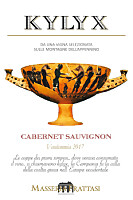
|
|
Kylyx 2017 |
|
| Masseria Frattasi (Campania, Italy) | |
 Cabernet Sauvignon Cabernet Sauvignon | |
| Price: € 120.00 | Score: |
 Intense ruby red and nuances of garnet red, little transparency. Intense ruby red and nuances of garnet red, little transparency. Intense, clean, pleasing, refined and elegant, starts with hints of
black currant, plum and black cherry followed by aromas of dried violet,
blueberry, bell pepper, cocoa, tobacco, rosemary, cinchona, rhubarb, cigar
box, licorice, mace, vanilla and eucalyptus. Intense, clean, pleasing, refined and elegant, starts with hints of
black currant, plum and black cherry followed by aromas of dried violet,
blueberry, bell pepper, cocoa, tobacco, rosemary, cinchona, rhubarb, cigar
box, licorice, mace, vanilla and eucalyptus.
 Properly tannic attack and however balanced by alcohol, full body,
intense flavors, pleasing roundness. Properly tannic attack and however balanced by alcohol, full body,
intense flavors, pleasing roundness.
 Very persistent finish with long flavors of black currant, plum and
black cherry. Very persistent finish with long flavors of black currant, plum and
black cherry.
 14 months in barrique. 14 months in barrique. |
|
 Game, Roasted meat, Stewed and braised meat, Hard cheese Game, Roasted meat, Stewed and braised meat, Hard cheese |
|
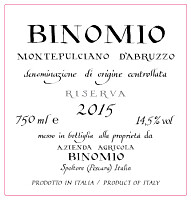
|
|
Montepulciano d'Abruzzo Riserva Binomio 2015 |
|
| La Valentina (Abruzzo, Italy) | |
 Montepulciano Montepulciano | |
| Price: € 32.00 | Score: |
 Deep ruby red and nuances of garnet red, little transparency. Deep ruby red and nuances of garnet red, little transparency. Intense, clean, pleasing, refined and elegant, starts with hints of
plum, black cherry and dried violet followed by aromas of blackberry,
blueberry, black currant, cocoa, tobacco, licorice, leather, graphite,
vanilla and menthol. Intense, clean, pleasing, refined and elegant, starts with hints of
plum, black cherry and dried violet followed by aromas of blackberry,
blueberry, black currant, cocoa, tobacco, licorice, leather, graphite,
vanilla and menthol.
 Properly tannic attack and however balanced by alcohol, full body,
intense flavors, pleasing roundness. Properly tannic attack and however balanced by alcohol, full body,
intense flavors, pleasing roundness.
 Very persistent finish with long flavors of plum, black cherry and
blackberry. Very persistent finish with long flavors of plum, black cherry and
blackberry.
 15 months in barrique. 15 months in barrique. |
|
 Game, Roasted meat, Stewed and braised meat, Hard cheese Game, Roasted meat, Stewed and braised meat, Hard cheese |
|
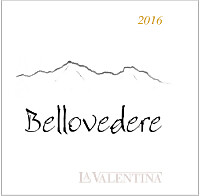
|
|
Montepulciano d'Abruzzo Riserva Terre dei Vestini Bellovedere 2016 |
|
| La Valentina (Abruzzo, Italy) | |
 Montepulciano Montepulciano | |
| Price: € 40.00 | Score: |
 Deep ruby red and nuances of ruby red, little transparency. Deep ruby red and nuances of ruby red, little transparency. Intense, clean, pleasing, refined and elegant, starts with hints of
black cherry, plum and blackberry followed by aromas of violet, blueberry,
black currant, tobacco, cocoa, cinnamon, leather, licorice, pink pepper,
menthol and vanilla. Intense, clean, pleasing, refined and elegant, starts with hints of
black cherry, plum and blackberry followed by aromas of violet, blueberry,
black currant, tobacco, cocoa, cinnamon, leather, licorice, pink pepper,
menthol and vanilla.
 Properly tannic attack and however balanced by alcohol, full body,
intense flavors, pleasing roundness. Properly tannic attack and however balanced by alcohol, full body,
intense flavors, pleasing roundness.
 Very persistent finish with long flavors of plum, black cherry and
blackberry. Very persistent finish with long flavors of plum, black cherry and
blackberry.
 18 months in cask and barrique, 12 months in bottle. 18 months in cask and barrique, 12 months in bottle. |
|
 Game, Roasted meat, Stewed and braised meat, Hard cheese Game, Roasted meat, Stewed and braised meat, Hard cheese |
|
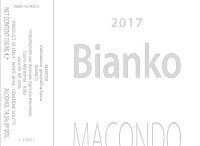
|
|
Bianko 2017 |
|
| Macondo (Marches, Italy) | |
 Trebbiano Toscano (60%), Pecorino (40%) Trebbiano Toscano (60%), Pecorino (40%) | |
| Price: € 95.00 | Score: |
 Brilliant golden yellow and nuances of golden yellow, very transparent. Brilliant golden yellow and nuances of golden yellow, very transparent. Intense, clean, pleasing, refined and elegant, starts with hints of
apple, plum and honey followed by aromas of hawthorn, medlar, pear,
grapefruit, saffron, rosemary, artemisia, butter, coffee, almond, bread
crust, praline, mineral and vanilla. Intense, clean, pleasing, refined and elegant, starts with hints of
apple, plum and honey followed by aromas of hawthorn, medlar, pear,
grapefruit, saffron, rosemary, artemisia, butter, coffee, almond, bread
crust, praline, mineral and vanilla.
 Crisp attack and however balanced by alcohol, full body, intense
flavors, pleasing roundness. Crisp attack and however balanced by alcohol, full body, intense
flavors, pleasing roundness.
 Very persistent finish with long flavors of apple, plum and honey. Very persistent finish with long flavors of apple, plum and honey. 22 months in barrique, 4 months in bottle. 22 months in barrique, 4 months in bottle. |
|
 Roasted white meat, Roasted fish, Broiled fish, Stewed meat, Cheese Roasted white meat, Roasted fish, Broiled fish, Stewed meat, Cheese |
|
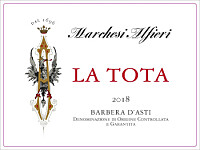
|
|
Barbera d'Asti La Tota 2018 |
|
| Marchesi Alfieri (Piedmont, Italy) | |
 Barbera Barbera | |
| Price: € 12.00 | Score: |
 Intense ruby red and nuances of ruby red, little transparency. Intense ruby red and nuances of ruby red, little transparency. Intense, clean, pleasing and refined, starts with hints of cherry, plum
and blueberry followed by aromas of violet, raspberry, strawberry, tobacco,
cocoa, vanilla and menthol. Intense, clean, pleasing and refined, starts with hints of cherry, plum
and blueberry followed by aromas of violet, raspberry, strawberry, tobacco,
cocoa, vanilla and menthol.
 Properly tannic attack and however balanced by alcohol, good body,
intense flavors, pleasing crispness. Properly tannic attack and however balanced by alcohol, good body,
intense flavors, pleasing crispness.
 Persistent finish with flavors of cherry, plum and blueberry. Persistent finish with flavors of cherry, plum and blueberry. Aged in barrique. Aged in barrique. |
|
 Stuffed pasta with mushrooms, Stewed meat with mushrooms, Roasted white meat Stuffed pasta with mushrooms, Stewed meat with mushrooms, Roasted white meat |
|
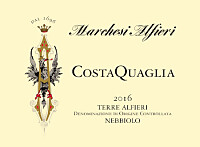
|
|
Terre Alfieri Nebbiolo Costa Quaglia 2016 |
|
| Marchesi Alfieri (Piedmont, Italy) | |
 Nebbiolo Nebbiolo | |
| Price: € 17.50 | Score: |
 Brilliant ruby red and nuances of garnet red, moderate transparency. Brilliant ruby red and nuances of garnet red, moderate transparency. Intense, clean, pleasing and refined, starts with hints of cherry, plum
and violet followed by aromas of raspberry, rose, cinnamon, tobacco,
chocolate, vanilla and menthol. Intense, clean, pleasing and refined, starts with hints of cherry, plum
and violet followed by aromas of raspberry, rose, cinnamon, tobacco,
chocolate, vanilla and menthol.
 Properly tannic attack and however balanced by alcohol, good body,
intense flavors, agreeable. Properly tannic attack and however balanced by alcohol, good body,
intense flavors, agreeable.
 Persistent finish with flavors of cherry, plum and raspberry. Persistent finish with flavors of cherry, plum and raspberry. Aged in barrique. Aged in barrique. |
|
 Broiled meat and barbecue, Roasted meat, Stewed meat with mushrooms, Cheese Broiled meat and barbecue, Roasted meat, Stewed meat with mushrooms, Cheese |
|

|
|
Colli di Luni Vermentino Sarticola 2019 |
|
| Cantine Federici - La Baia del Sole (Liguria, Italy) | |
 Vermentino Vermentino | |
| Price: € 25.00 | Score: |
 Brilliant straw yellow and nuances of greenish yellow, very
transparent. Brilliant straw yellow and nuances of greenish yellow, very
transparent.
 Intense, clean, pleasing, refined and elegant, starts with hints of
pear, broom and peach followed by aromas of apple, pineapple, passion
fruit, hawthorn, broom, chamomile, tangerine, plum, mint, almond and
mineral. Intense, clean, pleasing, refined and elegant, starts with hints of
pear, broom and peach followed by aromas of apple, pineapple, passion
fruit, hawthorn, broom, chamomile, tangerine, plum, mint, almond and
mineral.
 Crisp attack and however balanced by alcohol, good body, intense
flavors, agreeable. Crisp attack and however balanced by alcohol, good body, intense
flavors, agreeable.
 Persistent finish with flavors of pear, peach and passion fruit. Persistent finish with flavors of pear, peach and passion fruit. Aged in steel tanks. Aged in steel tanks. |
|
 Pasta with fish, Stewed fish, Fried fish, Broiled crustaceans Pasta with fish, Stewed fish, Fried fish, Broiled crustaceans |
|
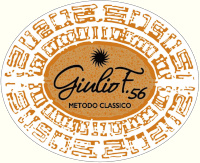
|
|
Metodo Classico Extra Brut Giulio F. 56 2017 |
|
| Cantine Federici - La Baia del Sole (Liguria, Italy) | |
 Vermentino Vermentino | |
| Price: € 35.00 | Score: |
 Brilliant golden yellow and nuances of golden yellow, very
transparent, fine and persistent perlage. Brilliant golden yellow and nuances of golden yellow, very
transparent, fine and persistent perlage.
 Intense, clean, pleasing, refined and elegant, starts with hints of
apple, plum and citron followed by aromas of pineapple, bread crust, pear,
yeast, hawthorn, praline, butter, broom and almond. Intense, clean, pleasing, refined and elegant, starts with hints of
apple, plum and citron followed by aromas of pineapple, bread crust, pear,
yeast, hawthorn, praline, butter, broom and almond.
 Effervescent and crisp attack, however balanced by alcohol, good body,
intense flavors, agreeable. Effervescent and crisp attack, however balanced by alcohol, good body,
intense flavors, agreeable.
 Persistent finish with flavors of apple, plum and citron. Persistent finish with flavors of apple, plum and citron. The base wine ages in cask for 6 months. Refermented and aged in bottle
on its lees for 24 months. The base wine ages in cask for 6 months. Refermented and aged in bottle
on its lees for 24 months.
|
|
 Pasta with fish, Broiled fish, Roasted white meat, Mushroom soups Pasta with fish, Broiled fish, Roasted white meat, Mushroom soups |
|
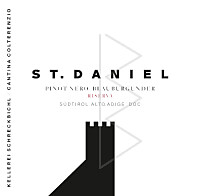
|
|
Alto Adige Pinot Nero Riserva St. Daniel 2017 |
|
| Produttori Colterenzio (Alto Adige, Italy) | |
 Pinot Nero Pinot Nero | |
| Price: € 16.60 | Score: |
 Brilliant ruby red and nuances of garnet red, moderate transparency. Brilliant ruby red and nuances of garnet red, moderate transparency. Intense, clean, pleasing, refined and elegant, starts with hints of
cherry, plum and raspberry followed by aromas of cyclamen, strawberry,
dried rose, blueberry, cocoa, tobacco, cinnamon, mace, menthol and vanilla. Intense, clean, pleasing, refined and elegant, starts with hints of
cherry, plum and raspberry followed by aromas of cyclamen, strawberry,
dried rose, blueberry, cocoa, tobacco, cinnamon, mace, menthol and vanilla.
 Properly tannic attack and however balanced by alcohol, good body,
intense flavors, pleasing crispness. Properly tannic attack and however balanced by alcohol, good body,
intense flavors, pleasing crispness.
 Persistent finish with flavors of cherry, plum and raspberry. Persistent finish with flavors of cherry, plum and raspberry. 12 months in cask and barrique, 12 months in bottle. 12 months in cask and barrique, 12 months in bottle. |
|
 Stuffed pasta with mushrooms, Roasted meat, Stewed meat with mushrooms Stuffed pasta with mushrooms, Roasted meat, Stewed meat with mushrooms |
|

|
|
Alto Adige Chardonnay Lafoa 2018 |
|
| Produttori Colterenzio (Alto Adige, Italy) | |
 Chardonnay Chardonnay | |
| Price: € 24.50 | Score: |
 Brilliant straw yellow and nuances of straw yellow, very transparent. Brilliant straw yellow and nuances of straw yellow, very transparent. Intense, clean, pleasing, refined and elegant, starts with hints of
pear, apple and acacia followed by aromas of grapefruit, mango, plum,
citron, pear, melon, praline, butter and vanilla. Intense, clean, pleasing, refined and elegant, starts with hints of
pear, apple and acacia followed by aromas of grapefruit, mango, plum,
citron, pear, melon, praline, butter and vanilla.
 Crisp attack and however balanced by alcohol, good body, intense
flavors, pleasing roundness. Crisp attack and however balanced by alcohol, good body, intense
flavors, pleasing roundness.
 Persistent finish with flavors of banana, apple and mango. Persistent finish with flavors of banana, apple and mango. 10 months in barrique, 6 months in bottle. 10 months in barrique, 6 months in bottle. |
|
 Stuffed pasta with fish, Broiled fish, Roasted fish, Roasted white meat Stuffed pasta with fish, Broiled fish, Roasted fish, Roasted white meat |
|

|
|
Nero di Predappio 2019 |
|
| Nicolucci (Emilia-Romagna, Italy) | |
 Terrano (80%), Sangiovese (20%) Terrano (80%), Sangiovese (20%) | |
| Price: € 20.00 | Score: |
 Brilliant ruby red and nuances of ruby red, moderate transparency. Brilliant ruby red and nuances of ruby red, moderate transparency. Intense, clean, pleasing and refined, starts with hints of cherry, plum
and raspberry followed by aromas of violet, blueberry, blackberry, cut
grass, cyclamen, black pepper and hints of vanilla. Intense, clean, pleasing and refined, starts with hints of cherry, plum
and raspberry followed by aromas of violet, blueberry, blackberry, cut
grass, cyclamen, black pepper and hints of vanilla.
 Properly tannic attack and however balanced by alcohol, good body,
intense flavors, agreeable. Properly tannic attack and however balanced by alcohol, good body,
intense flavors, agreeable.
 Persistent finish with flavors of cherry, plum and raspberry. Persistent finish with flavors of cherry, plum and raspberry. 6 months in barrique, 3 months in bottle. 6 months in barrique, 3 months in bottle. |
|
 Stuffed pasta with mushrooms, Stewed meat with mushrooms, Legume soups Stuffed pasta with mushrooms, Stewed meat with mushrooms, Legume soups |
|
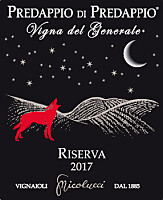
|
|
Romagna Sangiovese Superiore Riserva Predappio di Predappio Vigne del Generale 2017 |
|
| Nicolucci (Emilia-Romagna, Italy) | |
 Sangiovese Sangiovese | |
| Price: € 26.00 | Score: |
 Intense ruby red and nuances of garnet red, moderate transparency. Intense ruby red and nuances of garnet red, moderate transparency. Intense, clean, pleasing, refined and elegant, starts with hints of
black cherry, plum and violet followed by aromas of blueberry, raspberry,
geranium, pomegranate, blackberry, chocolate, tobacco, mace, vanilla and
menthol. Intense, clean, pleasing, refined and elegant, starts with hints of
black cherry, plum and violet followed by aromas of blueberry, raspberry,
geranium, pomegranate, blackberry, chocolate, tobacco, mace, vanilla and
menthol.
 Properly tannic attack and however balanced by alcohol, good body,
intense flavors, agreeable. Properly tannic attack and however balanced by alcohol, good body,
intense flavors, agreeable.
 Persistent finish with flavors of black cherry, plum and blueberry. Persistent finish with flavors of black cherry, plum and blueberry. 2 years in cask, 3 months in bottle. 2 years in cask, 3 months in bottle. |
|
 Broiled meat and barbecue, Roasted meat, Stewed meat with mushrooms, Cheese Broiled meat and barbecue, Roasted meat, Stewed meat with mushrooms, Cheese |
|
News |
|
In this section are published news and information about events concerning the world of wine and food. Whoever is interested in publishing this kind of information can send us a mail to our address.
|
AquavitaeReview of Grappa, Distillates and Brandy |
|
|
||||||||||||||
Wine Guide ParadeJune 2020
|
| |||||||
Privacy Policy | |||||||


| Copyright © 2002-2024 Antonello Biancalana, DiWineTaste - All rights reserved |
| All rights reserved under international copyright conventions. No part of this publication and of this WEB site may be
reproduced or utilized in any form or by any means, electronic or mechanical, without permission in writing from DiWineTaste. |